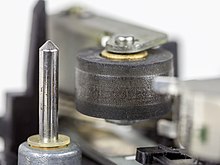Capstan

A capstan (English name for the capstan ), also capstan , is a rotating shaft , which in combination with a pressure roller is used, the tape in a tape device ( tape recorder , cassette recorder , cutting table , scanner , video tape recorder ) with a constant speed at the head finishing off. In high-quality devices, the capstan is driven by its own motor . To improve synchronization, it is usually connected to a flywheel .
A capstan is manufactured and polished with high precision. An irregularity can be heard as a "flutter" or tremolo , especially in higher pitches.
Drives for compact cassettes with "Autoreverse" have two capstan shafts running against each other, the pressure rollers of which are pressed individually onto their capstan shaft for the respective tape direction.
High-quality devices have a double capstan drive, which transports the tape before and after the tape head more evenly. The synchronization is improved and tension fluctuations when winding the tape are reduced.
The belt speed should be as constant as possible. The smaller spool rotates faster than the large one, which is compensated for by a slip clutch . If the tape gets stuck on the capstan or on the pressure roller as a result of abrasion and contamination, this creates tape salad .
Individual evidence
- ↑ Technical information on the Capstan at www.tonbandmuseum.info, accessed on September 29, 2016

